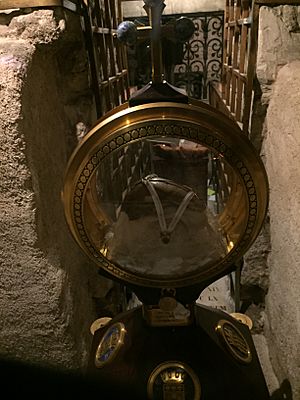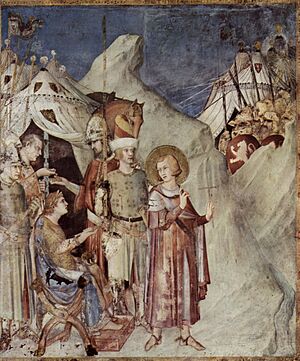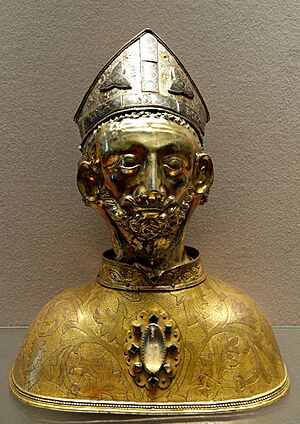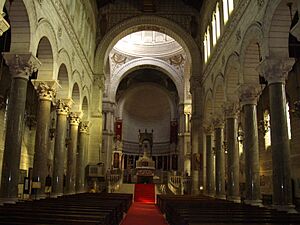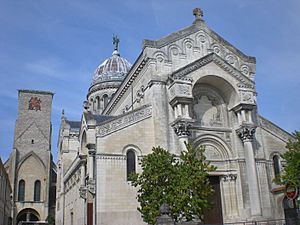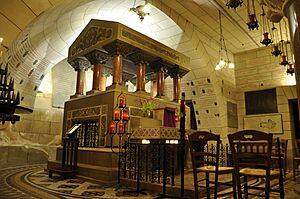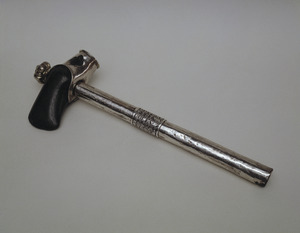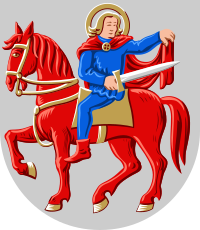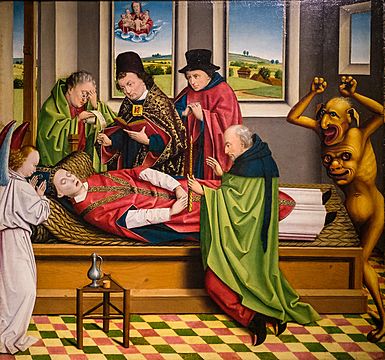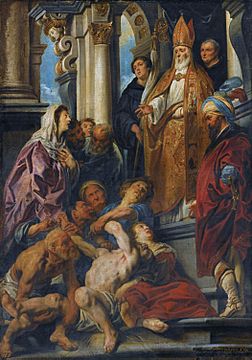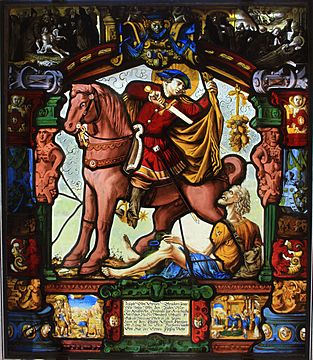Martin of Tours facts for kids
Quick facts for kids SaintMartin of Tours |
|
|---|---|
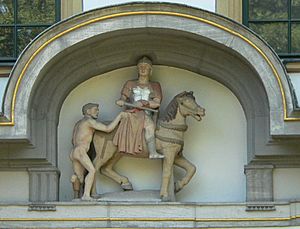
Statue of Saint Martin cutting his cloak in two. Höchster Schloss, Höchst.
|
|
| Bishop and Confessor | |
| Born | 316 or 336 Savaria in the Diocese of Pannonia |
| Died | 8 November 397 (aged 60–81) Candes, Gaul |
| Venerated in | Catholic Church Eastern Orthodox Church Oriental Orthodoxy Anglican Communion Lutheranism |
| Canonized | Pre-Congregation |
| Feast | 11 November (Catholic Church, Lutheran Church, and Anglican Communion) 12 October (Eastern Orthodox Church) |
| Attributes | man on horseback sharing his cloak with a beggar; man cutting cloak in half; globe of fire; goose |
| Patronage | against poverty; Baħrija, Malta; beggars; Beli Manastir; Archdiocese of Bratislava; Buenos Aires; Burgenland; cavalry; Church Lads' and Church Girls' Brigade; Dieburg; Edingen equestrians; Foiano della Chiana; France; geese; horses; hotel-keepers; innkeepers; Kortrijk; diocese of Mainz; Montemagno; Olpe; Ourense; Pietrasanta; Pontifical Swiss Guards; quartermasters; riders; Taal, Batangas; Touraine; Bocaue, Bulacan; Diocese of Rottenburg-Stuttgart; soldiers; tailors; Utrecht; vintners; Virje; wine growers; wine makers; Wissmannsdorf and Villadoz; Torre di Mosto |
Martin of Tours (also known as Martin the Merciful) was an important Christian saint from the 4th century. He was the third bishop of Tours in what is now France. Martin is one of the most famous Christian saints in France and is a patron saint for many groups and places across Europe.
He was born in central Europe and became a Christian when he was young. He served in the Roman cavalry in Gaul (modern-day France). Later, he left the army and became a student of Hilary of Poitiers. He founded a monastery at Ligugé. In 371, he became the Bishop of Tours. As bishop, he worked to spread Christianity. He also famously opposed violence against people who had different Christian beliefs.
Martin's life story was written by his friend, Sulpicius Severus. One of the most famous stories about him is how he cut his cloak in half to share with a poor beggar. His shrine in Tours became a popular stop for pilgrims traveling to Santiago de Compostela in Spain.
Contents
The Story of Saint Martin
Martin's early life was written down by his friend, Sulpicius Severus. Sulpicius was a Christian writer who knew Martin well. His book tells us how Christians in the 300s felt about the Devil. It also shares stories of miracles Martin performed. These miracles include casting out evil spirits and healing sick or even dead people.
Other stories tell of Martin's special powers. For example, flames from a burning Roman temple turned away from a nearby house because of him. He also changed the direction of a falling sacred tree. People believed that letters written by Martin had healing power.
His Early Life as a Soldier
Martin was born in AD 316 or 336 in Savaria, which is now Szombathely, Hungary. His father was a high-ranking officer in the Roman army. A few years after Martin was born, his father retired. He was given land in northern Italy, where Martin grew up.
When he was 10, Martin started going to a Christian church. This was against his parents' wishes. Christianity had become a legal religion in the Roman Empire in 313. However, it was still a minority faith, especially among higher-ranking people and soldiers.
Because his father was a veteran officer, Martin had to join the cavalry at age 15. When he was about 18, he was stationed in Gaul (modern-day Amiens, France). He likely joined an elite cavalry unit that traveled with the Emperor.
Martin's biographer, Sulpicius Severus, didn't give exact dates. But he said Martin served in the military for "nearly two years after his baptism." Historians believe he served under Emperors Constantine II and Julian.
Before a battle in Gaul, Martin decided to leave the army. He told his commander, "I am the soldier of Christ: it is not lawful for me to fight." He was accused of being a coward and put in jail. But he offered to go to the front lines without weapons. Before he could, the enemy asked for peace. The battle never happened, and Martin was released from military service.
Becoming a Monk and Hermit
After leaving the army, Martin went to Tours. There, he became a student of Hilary of Poitiers, a Christian leader. Martin opposed a different Christian belief called Arianism, which was supported by the Imperial Court. When Hilary was sent away, Martin returned to Italy.
According to Sulpicius, Martin converted a robber in the Alps. He also faced the Devil himself. After a dream, Martin went back to his home region. He converted his mother and others to Christianity, but not his father. He was even publicly whipped for speaking out against Arians.
Martin was then forced to leave Milan. He found shelter on an island called Gallinaria, where he lived as a hermit. He wasn't completely alone, as a priest and Hilary joined him for a time. Martin ate wild herbs and roots. A legend says he ate a poisonous plant but was miraculously cured after praying.
When Hilary returned in 361, Martin joined him. He set up a hermitage nearby, which soon attracted many followers. This place became Ligugé Abbey, the oldest known monastery in Europe. It became a center for spreading Christianity in the countryside. Martin traveled and preached throughout western Gaul.
Becoming a Bishop
In AD 371, Martin was chosen to be the bishop of Tours. He was known for his humble behavior. He was tricked into coming to Tours, supposedly to help a sick person. Once there, he was brought to the church and reluctantly agreed to become bishop.
According to one story, he tried to hide in a barn full of geese to avoid being made bishop. But the geese's loud cackling gave him away! Some people complained that he looked too messy to be a bishop. But many more people supported him.
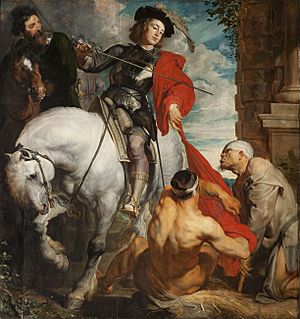
Sulpicius says that Martin moved out of the city to live in Marmoutier. This was a monastery he founded across the river Loire from Tours. Martin and his monks built simple wooden cells or lived in caves dug into the rock.
Martin started a basic system for churches in different areas. Once a year, he visited each church, traveling on foot, by donkey, or by boat. He continued to create new monastic communities. He also expanded the area of his bishopric to include places like Chartres and Paris.
In one story, non-Christians agreed to cut down their sacred pine tree if Martin stood in its path. He did, and the tree miraculously missed him. Martin was also known for trying to free prisoners. Authorities and even emperors would try to avoid him because they knew he would ask for mercy for someone.
Protecting Others
Churches in Gaul and Spain were troubled by the Priscillianists, a group with different Christian beliefs. Their leader was Priscillian. Martin strongly disagreed with the Priscillianists' beliefs. However, he traveled to the Imperial court to protect them from being judged by the emperor.
Martin believed that people with different religious views should not be put to death. He also thought the emperor should not interfere in such matters. He convinced the emperor to spare Priscillian's life. But after Martin left, the emperor changed his mind. He ordered Priscillian and his followers to be executed in 385.
Martin was very sad about this. He refused to speak with the bishop who pushed for the executions. Martin then asked for the persecution of Priscillian's followers to stop.
Martin died in Candes-Saint-Martin, France, in 397. After he died, people from different regions argued over where he should be buried. One night, people from Tours secretly took Martin's body to a boat on the Loire river. They rowed his body to Tours, where a large crowd waited. A chronicle says that "2,000 monks, and nearly as many white-robed virgins" walked in the procession. They accompanied his body to a small grove outside Tours, where he was buried.
Marmoutier Abbey
Marmoutier Abbey was a monastery founded by Martin around 372, just outside Tours. Martin started it to live a quiet monastic life away from attention. This Abbey became very important in medieval France. Later, the famous scholar Alcuin became its abbot.
Alcuin's writing room (scriptorium) at Tours developed a clear writing style called Caroline minuscule. This made manuscripts much easier to read.
Over time, the abbey was destroyed by fire and attacked by Vikings. It was rebuilt several times. The shrine of St. Martin became a major stop for pilgrims. During the French Wars of Religion, the basilica was attacked in 1562. It was later destroyed during the French Revolution. Its stones were sold, and streets were built over the site.
The Legend of Saint Martin's Cloak
While Martin was a soldier in the Roman army in Gaul, he had a vision. This vision became the most famous story about his life. One cold winter day, as he was entering the city of Amiens, he saw a beggar who was barely clothed. Martin quickly cut his military cloak in half and gave one half to the man.
That night, Martin dreamed of Jesus. In his dream, Jesus was wearing the half-cloak Martin had given away. He heard Jesus say to the angels: "Martin, who is still learning about Christianity, clothed me with this robe." In another version, Martin woke up to find his cloak whole again. This dream made Martin even more devoted to his faith, and he was baptized at age 18.
The half of the cloak Martin kept became a famous holy object. It was kept by the kings of the Franks near Tours. During the Middle Ages, this cloak was carried by the king into battle. It was also used for swearing important oaths.
The priest who looked after this cloak was called a cappellanu. Over time, all priests who served the military became known as chaplains. The small temporary churches built for the cloak were called "capella," meaning "little cloak." Eventually, all small churches became known as "chapels."
Honoring Saint Martin
Saint Martin was very popular in the Middle Ages, especially in France. People believed that "Wherever Christ is known, Martin is honored."
When Bishop Perpetuus took office in Tours in 461, the small chapel over Martin's grave was too small for all the pilgrims. Perpetuus built a much larger church. Martin's body was moved from his hermitage to Tours. His tomb was reburied behind the main altar of the new church. A large marble block made the tomb visible to people.
Saint Martin's popularity grew because French kings supported him. Clovis I, a king of the Franks, believed St. Martin helped him win battles. He credited St. Martin with his success and became Christian. Devotion to St. Martin continued with later French kings.
The bishop Gregory of Tours wrote an important book about St. Martin's life, filled with miracle stories. Martin is honored in the Church of England and the Episcopal Church on November 11.
Saint Martin's Popularity in Modern France
In 1860, parts of the old abbey were found during excavations. St. Martin's tomb was rediscovered on December 14, 1860. This helped bring back popular devotion to St. Martin in the 1800s.
After a difficult period in France, people decided to build a new church for St. Martin. The new Basilique Saint-Martin was started in 1886 and finished in 1925.
The Franco-Prussian War
Martin's popularity in France increased during the Franco-Prussian War of 1870–1871. During this war, the French government moved to Tours for a short time.
Religious leaders promoted St. Martin as a protector of the nation against the German threat. They saw the war as a punishment for France moving away from religion. They encouraged people to return to faith for stability. The ruined towers of St. Martin's old church in Tours became a symbol of traditional Catholic France's decline.
Many pilgrims visited St. Martin's tomb in Tours during the war. A temporary chapel was built over it. People believed St. Martin's protection helped the French army win a battle. Popular songs from the 1870s spoke of national protection under Martin's cloak, calling it the "first flag of France."
During the 1800s, many Frenchmen left the church due to new ideas. But devotion to St. Martin was an exception, especially for men. For soldiers, Martin was presented as a model of good behavior. He was seen as a brave fighter who cared for the poor, shared his belongings, and respected authority.
Challenges from Anti-Religious Groups
In the 1870s, public religious parades to St. Martin's tomb became a symbol of cooperation between the church and the military. Army officers in uniform would escort the clergy. However, anti-religious groups saw these parades as an invasion of public spaces. In 1878, the mayor of Tours banned the November procession for St. Martin.
This struggle showed the conflict between religious conservatives and anti-religious groups over the church's role in the army. Laws were passed to reduce the number of military chaplains. Anti-religious lawmakers wanted commanders, not chaplains, to provide moral support to troops.
Saint Martin as a French Symbol
St. Martin had long been linked to France's royal history. Later, an Archbishop of Tours worked to make St. Martin a "republican" symbol. He believed France's victories were due to St. Martin. He connected Martin's cloak, the "first flag of France," to the French flag. This linked St. Martin to the French Republic.
However, tensions grew between the Church and the Republic. By 1905, the church and state were officially separated in France.
St. Martin's popularity returned during World War I. Anti-religious feelings decreased, and priests served as chaplains in the French army. In 1916, a national pilgrimage to Tours attracted people from all over France. Special prayers were offered to St. Martin. When the war ended on St. Martin's Day, November 11, 1918, many French people saw it as a sign of his help.
Who Does Saint Martin Protect?

Saint Martin is the patron saint of many groups. He protects beggars, wool-weavers, and tailors because he shared his cloak. He is also the patron saint of the US Army Quartermaster Corps, even though he disliked violence.
He is also the patron saint of geese. Some say this is because geese gave away his hiding place when he tried to avoid becoming bishop. Others say it's because geese migrate around his feast day. He is also the patron saint of winemakers and innkeepers, as his feast day is just after the grape harvest. He is also a patron saint of France.
Saint Martin is seen as a "spiritual bridge across Europe." This is because he was born in central Europe and lived most of his adult life in France.
How Saint Martin is Shown in Art
Martin is usually shown on horseback, dividing his cloak with a beggar. In English art, his symbol is often a goose. This is because geese migrate in late autumn, around his feast day.
The Hammer of Martin of Tours
A museum in the Netherlands has a relic called "the hammer of St. Martin of Tours." It was made in the 13th or 14th century from an old stone axe. The axe has a Latin text that says, "the pagan statues fall down, hit by St. Martin's axe. Let nobody believe that those are gods, who so easily fall down." Legend says the axe belonged to St. Martin. It was used to fight the devil and destroy non-Christian temples and statues.
Saint Martin's Influence
By the early 800s, Saint Martin was well-known in Ireland. His monastery at Marmoutiers trained many missionaries. Some believe that St. Patrick was his nephew and studied there. St. Ninian definitely studied at Marmoutiers and was greatly influenced by Martin. Ninian dedicated a church to Martin when he heard of his death.
Old Irish texts, like The Book of Armagh, include writings about Saint Martin. This shows how important he was to early Irish Christians.
Saint Martin's Legacy
Ligugé Abbey
Ligugé Abbey was founded by Martin of Tours in 360. It is one of the oldest monasteries in France. Many followers came to the new monastery. Its fame was later overshadowed by Martin's other monastery, Marmoutier. Today, the Benedictine community at Ligugé still has about twenty-five monks.
European Traditions
From the late 300s to the late Middle Ages, many parts of Western Europe had a fasting period. It began the day after St. Martin's Day, November 11. This fast lasted 40 days (not counting Saturdays and Sundays). It was called "the forty days of St. Martin." On St. Martin's Eve and on the feast day, people would eat and drink a lot before starting their fast. This fasting time later became known as "Advent" by the Church. It was a time to prepare for Christmas.
On St. Martin's Day, children in some parts of Europe still have paper lantern processions. Often, a man dressed as St. Martin rides a horse at the front. The children sing songs about St. Martin and their lanterns. The traditional food for the day is goose. Legend says Martin hid in a stable full of geese to avoid becoming bishop. The geese's noise gave him away.
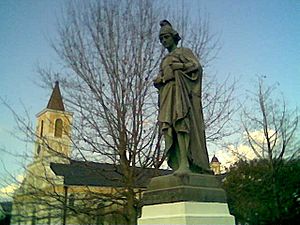
In some parts of Belgium, children receive presents from St. Martin on November 11. This is instead of from Saint Nicholas or Santa Claus. They also have lantern processions, sometimes with lanterns made from beets. These processions have become popular even in Protestant areas of Germany and the Netherlands.
In Portugal, families and friends gather around fires for "magustos." They eat roasted chestnuts and drink wine. A popular version of the cloak story says that after Martin gave away his cloak, the dark clouds cleared. The sun shone brightly, melting the frost. This warm weather on November 11 is called Verão de São Martinho (Saint Martin's Summer).
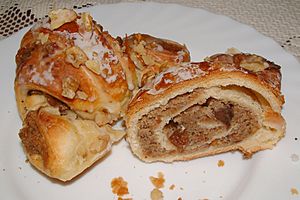
In Malta, children leave an empty bag by their bed on St. Martin's Eve. The next day, they find it full of fruit.
Many churches are named after Saint Martin of Tours. St Martin-in-the-fields in London is one example. It is known for its connection to peace. Saint Martin's Cathedral in Belgium is also dedicated to him. St. Martin is the patron saint of Szombathely, Hungary, and Buenos Aires. In the Netherlands, he is the patron of Utrecht and Groningen.
He is also the patron of the church and town of Bocaue in the Philippines. St. Martin's Church in Kaiserslautern, Germany, is a major landmark. It was originally a Franciscan monastery built in the 1300s.
St. Martin is the patron saint of the Polish towns of Bydgoszcz and Opatów. His day is celebrated with a procession and festivities in Poznań, Poland. A special crescent cake (rogal świętomarciński) is baked for the occasion. November 11 is also Polish Independence Day, so it's a public holiday.
In Latin America, St. Martin is very popular. He is often called San Martín Caballero, meaning "Saint Martin the Horseman." Mexican folklore believes he helps business owners.
The largest Anglican church in North America is St Martin's Episcopal in Houston, Texas. It was the home church for President George H. W. Bush and his wife for many years.
San Martín de Loba is a town in Colombia named after him. Saint Martin is also the patron saint of Vasquez, a small village in Colombia.
In Finland, the town of Marttila is named after St. Martin and shows him on its coat of arms.
Although early writers didn't mention it, St. Martin is now credited with spreading winemaking in the Touraine region of France. He is also believed to have introduced the Chenin blanc grape.
Martin Luther was named after St. Martin. He was baptized on November 11 (St. Martin's Day) in 1483. Many older Lutheran churches are named after St. Martin, which is unusual for Lutherans.
Martin of Tours is the patron saint of the United States Army Quartermaster Corps. They have a medal named after him. The Church Lads' and Church Girls' Brigade, a youth group, renamed their 5–7 age group 'Martins' in his honor in 1998.
Many schools have St. Martin as their patron, such as St. Martin's School in Johannesburg.
In Art and Movies
The Dutch film Flesh and Blood (1985) features a statue of Saint Martin. A mercenary named Martin sees the statue of Saint Martin cutting his cloak. He takes it as a sign to leave his group and travel under the saint's protection.
- Saint Martin in art
Bay 20 in the Chartres Cathedral shows the life of St. Martin in a 40-panel stained glass window.
See also
 In Spanish: Martín de Tours para niños
In Spanish: Martín de Tours para niños


